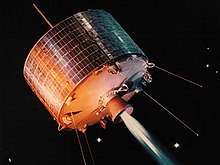Apogee motor

The apogee motor ( English Apogee boost motor , Apogee kick motor) is a rocket engine of a satellite to reach the final orbit .
Launchers do not put satellites directly into high orbital orbit. Instead, they deposit the payload in a strongly elliptical orbit, the apogee (point away from the earth) approximating the radius of the desired orbit. In geostationary satellites, the transfer orbit is called geostationary transfer orbit (abk. English GTO) if the satellite is to be positioned geostationary . The name for the apogee engine is derived from the ignition timing. By starting the motor in apogee, it raises the perigee (point close to the earth) and reduces the eccentricity of the satellite orbit.
Various technologies are used in apogee engines:
- Solid propulsion: a small solid rocket engine is often used for smaller satellites. This raises the perigee during the approx. One minute burning phase in apogee. Because it can only be ignited once, a correction (e.g. if the satellite is incorrectly aligned) is not possible. In most cases the engine will remain connected to the satellite, but it will be repelled, especially with numerous weather satellites.
- Liquid fuel engine : This is a small engine that is supplied with storable fuels (mostly dinitrogen tetroxide or mixed oxides of nitrogen and monomethylhydrazine ) via a pressurized gas feed. The engine is characterized by a relatively low thrust; for the S400 engine family from EADS, for example, it is around 400–425 N depending on the version . At the same time, a long burning time is typical, often five to ten minutes. The perigee is raised by igniting the engine several times during several passages of the apogee. Most of the apogee engines today (2013) are liquid propellants.
- Ion propulsion : The new ion propulsion is a special feature here , which is characterized by lower thrust but extremely long burning times: the thrust is significantly lower at around 70 mN, the burning time is extended to many days at intervals. A special GTO is required to use the ion thrusters.
There is now a satellite model that only has ion thrusters that emit xenon . By using ion propulsion as an apogee motor, these satellites are said to have only 33% to 50% of the weight of a satellite of the same power with a liquid fuel apogee motor. However, it takes a few months to raise the perigee to reach the geostationary orbit .
See also
Web links
- S400 apogee motors (English)